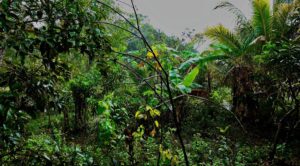
Western Belize, Central America — Narciso travels from his home to his planting tract by bicycle. He looks fit for a man his age and moves fluidly but not rapidly, as if he is conserving energy for the day. His machete is in his hand as we wind through a few of his hectares. This particular tract is well on its way to becoming forest again. Narciso wears rubber boots and appropriately-tattered western-style clothing. Deftly, he dings off annoying palm fronds with his lethal tool, then stops and does surgery on a tuber of some kind. He slices with an accuracy impossible from a blade so long, but suffers no wound. He smiles up at me as he delivers a forest lecture. The smile is warm and easy. Narciso is generous with his time, although there is work for him all around.
I met Narciso as I visited with Dr. Anabel Ford, an anthropologist with the University of California, Santa Barbara, and her team while traveling in western Belize. In her younger days, Dr. Ford had discovered the ancient Maya city of El Pilar, which straddles the Belize-Guatemala border. But, rather than starting to dig and restore, as most archeologists do, Dr. Ford and her team began to assess the surrounding forest for clues. They discovered that 90% of the trees around El Pilar yielded useful products such as fruits, nuts, various kinds of useful wood, fiber, and medicines. It appeared that the species that had no utility had been weeded out. The ancient Maya, Ford hypothesized, had treated their forests as gardens to be managed. With her on this day were two Maya forest gardeners named Alfonso Tzul, age 77, and Narciso Torrres, age 64. These men were our introduction to an almost pure form of environmentalism. They were not only committed to sound practice, but they fully understood the contrast between what they were doing and what was happening with the chemical and machine-based western-style agriculture going on all around them. Alfonso, in particular, was philosophical in communicating his world view. “A Maya boy goes to the river with his fishing pole,” he said, relating a favorite parable. “He is very happy when he catches a large fish that can feed his family for the day, and so he returns home. A man from the West catches a fish and right away asks himself if he could devise a method to catch many fish from the river and sell them for a profit.” At its heart is the issue of how we think about resources and to whom they belong.
_____________________________

Alfonso and Narciso in their Maya forest environment. RCK
_____________________________
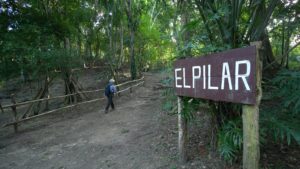
Depicted here: Dr. Anabel Ford walks through the El Pilar Archaeological Reserve. El Pilar is the largest ancient Maya city in the Belize River area. Recent excavations have revealed some twenty-five plazas, intricate palaces, and temples. Image by RCK
_____________________________
At the center of Alfonso’s and Narciso’s daily industry is each man’s own milpa, which brings to mind Ford’s book, The Maya Forest Garden, co-authored by ethnologist Ronald Nigh, in which the authors hypothesize that the ancient Maya had treated their forests as gardens to be managed. We discovered that “milpa” can refer to several things. True, it can be a corn field; but in a Maya field are likely to be many other crops interspersed among the corn stalks, especially varieties of beans and squash which, together with corn, make a diet of complete protein. Some 90 varieties of edible plants have been identified in Maya plots. This contrasts strongly with the maize monocultures of nearby mechanized farms.
Milpa, however, can also refer to a cyclical way of farming that Anabel claims goes back at least 4,000 years into ancient Maya history and is integral to her ideas. What we have condemned as “slash-and-burn” farming that destroys tropical rainforest in the Yucatan may be something far more complex and beneficial. Here’s how it works:
The farmer cuts and burns a piece of his forest. He has no way to remove all trees and stumps, so he purposely conserves them. The ash from the burned vegetation provides microelements for his crops. For about four years he plants and harvests in his milpa. This is labor intensive, for he relies on his own skill and labor instead of a plough. Rather, he uses a sharpened pole to jab holes in the ground for his seeds. I was astounded to see that crops could be grown on un-ploughed land. The Maya do this to preserve the soil biology (especially earthworms), to encourage helpful annuals to sprout and to eliminate the runoff of top soil during rains. Alfonso Tzul noted that he has never witnessed a plowed field without erosion and never seen a traditional milpa with erosion. Narciso Torres also knows that untilled land sequesters 4-5 times more carbon than ploughed land and retains more moisture for plant growth.
_____________________________
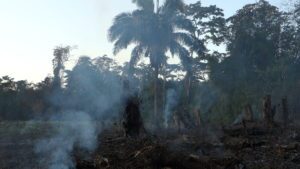
Burning the forest as part of the Milpa Cycle. RCK
_____________________________
The absence of ploughing by the Maya should not be overlooked. It was the use of the plough by American settlers that turned over the sod of the Great Plains. On the prairies grew many species of grasses, legumes and other perennials. Big Bluestem, for example, thrust its roots eight feet into the ground, binding the soil. Once the sod was busted, fragile annual grasses moved in, setting the stage for the Dust Bowl of the 1930s where naked top soils were picked up by the wind and carried east. A vast and complex ecosystem was lost by pure ignorance.
Our Maya forest gardener adds no commercial fertilizers to his land but will apply compost, burned debris from his fields and manures. He spends most of the day in his milpa weeding, planting and harvesting. He is satisfied in his work, excited by the cycles of life. He loves the feel and smell of the soil and, if he is a religious man like Alfonzo, he thanks God for the privilege of the intimacy he has with the land. Barring untimely heavy rains or drought, the farmer’s yield will be high, and he will have more food than he and his family can eat. Some he might take to market.
After four years, with at least two crops per year, the farmer begins to allow tree seedlings to reinvade his milpa from the surrounding forest. He keeps what will be useful and plants among the small trees and shrubs for another eight years or until there is too much shade for his annuals. At this point his milpa has been transformed.
For another eight years the trees, growing rapidly in the tropical climate, produce a closed canopy that quickly becomes home to monkeys, parrots and other rainforest animals. Eventually the farmer has reached the 20-year mark, and the cycle can start anew.
A key to the success of the Maya forest gardener is the fact that he has tracts of land in all stages of the milpa cycle at all times. At any given time, most of his land is forested, either partially or fully. Studies show that where the milpa system is used, 66-94% of the land is covered in forest both pioneering and mature. Streams run clear since topsoils, pesticides, herbicides and fertilizers are absent from the water. Areas of the landscape that are not suitable for milpa farming such as soils high in clay, cliffs, swamps and the borders of streams are left in canopy forest, with not only trees commonly used by the Maya but the full diversity of rainforest life.
_______________________________
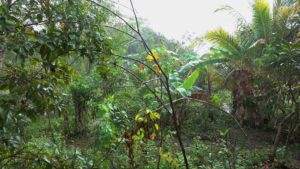
Narciso’s milpa in transition. RCK
_______________________________
In the Mexican state of Chiapas we also visited forested land managed by the Lacandon branch of the Maya not far from ancient sites like Palenque, Yaxchilan, Piedras Negras and Bonampak. Here my wife Judy and I met Victor Chambor, a young man dressed in the traditional white robe of the Lacandon. Victor proudly led us through a large tract of managed forest adjacent to his milpa while his sister Ofelia made tortillas for us on an earth-filled wooden hearth called a k’oben.
In the forest we were stunned by the towering height of the trees – some reaching over 200 ft. Victor was fully knowledgeable about all the plants and animals we saw. There were giant ceiba trees nearly eight feet in diameter just above their buttressed bases. These had been sacred to Victor’s distant ancestors who believed that the gods came to earth by way of the trees’ mighty branches. A swollen cascade pointed to how much water falls in Chiapas to account for the lushness of its rainforests, remarkable in all of Mexico. As we walked, Victor produced a cell phone which he is now using to make his guiding skills known to eco-tourists and filmmakers like us.
The Lacandon are noted for an intense version of farming called high-performance milpa that can bring maize yields of 2,800 kg per hectare, or higher. As Ford says, the Lacandon men “traditionally dedicated the greater part of their days to milpa work, in addition to hunting and gathering forest resources.” Like Alfonso, Narciso and other milperos, Victor knew the signs of when to plant and harvest each of his crops. For example, the third crop of corn is planted in May when the mahogany tree flowers. I could see that Victor’s skill and knowledge of soil and plants was so vast that it could only have been figured out through countless generations.
____________________________
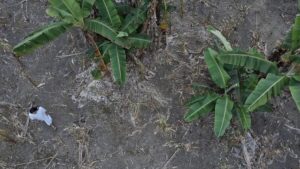
Above and below, aerial view of Victor in his milpa. RCK
____________________________
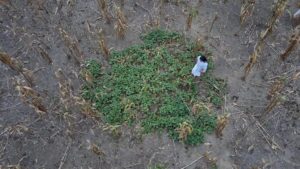
____________________________
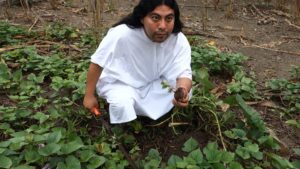
Victor shows a jicama tuber in his milpa. RCK
____________________________
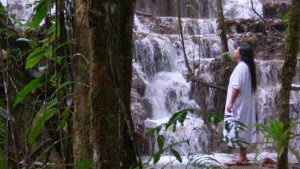
Victor at the cascade. RCK
____________________________
The Great Collapse?
Before I met Ford, my son Richard and I prowled books and magazines for the answer to the Maya collapse and discovered that things were still in hot debate. Most scholars have cobbled together a combination of causes, all backed up by evidence of some kind. Topping the list are overpopulation, drought when populations were high, deforestation, soil degradation, warfare and the failure of kings to solve ecological problems. We sought concrete answers in preparation for filming Rainforests of the Maya – a documentary to educate youth in the public schools of Miami. Then we encountered Ford, and our house of cards came down. We realized that she was challenging one of the main hypotheses of ancient Maya studies – that Maya civilization had collapsed largely due to environmental reasons. Furthermore, she was questioning whether the Maya had collapsed at all.
Jarred Diamond, the author of the book Collapse, claimed that the worst mistake in human history was the development of agriculture. With farming, we settled ourselves down, which accelerated our inventing, mining, and drilling. As hunter gatherers we were sustainable. As “civilized” people we were not.
One of the places where the domestication of plants and animals led to a sedentary life was in Mesoamerica. Should we be tempted to think that other cradles of civilization like Mesopotamia and Egypt were more impressive, we only have to appreciate the pyramids of Tikal and Calakmul for their immense size or the Palace at Sayil for its dazzling beauty to get an idea of the level of architecture achieved by the Maya. Their buildings and plazas were even stuccoed. (The Maya had invented a better cement than the Romans). Examine the deeply-incised door lintels at Yaxchilan, the painted murals at Bonampak or the jade death mask of Pacal, Palenque’s king, and you will see artistry that will astound you. In time, new architectural styles like Puuc and Rio Bec added pillars, towers, stucco masks, monster mouths and other ornamentations to monumental structures, while lighter roof combs at Yaxchilan and Palenque allowed for larger interior spaces and more light.
The sophisticated Mesoamerican life that evolved in the greater Yucatan from before 1000 BC until the brutal Spanish conquest was made possible by the domestication of corn, beans, squash and turkeys as well as modifications to the surrounding forests. Amazingly, the Maya had no horses or oxen for hefting loads and no cows, goats or sheep for meat. Those animals were brought to the New World by the conquistadores much later.
Despite the lack of many of the things we think are important, the Maya invented a written hieroglyphic language, created an accurate calendar based on their astronomical observations, developed the mathematical concept of zero and supported a ruling class with scribes, priests and kings. Maya kingdoms were established from western Honduras and El Salvador, to Guatemala, Belize and throughout the Mexican Yucatan. The total Maya population probably reached well over ten million, perhaps twenty million at its peak, which is greater than the population in those areas today. Then, there were alliances between kings, and there were wars.
We know little about how the common man and woman lived. However, the Maya kings boasted of military victories by directing artisans to erect limestone slabs covered in hieroglyphs, dates and human figures. These stelae ceased around 910 AD to signal the end of the Classic Period. Something had clearly changed. To use Jared Diamond’s term, it seemed to most archeologists that the world of the Maya had collapsed. The only question was why; and it could be said that this question became the biggest mystery in all of archeology. Today tourists look at abandoned city centers at sites like Tikal and ask “Whatever happened to the Maya?” Alphonso always replies, “Nothing happened to them. You’re talking to one.”
____________________________
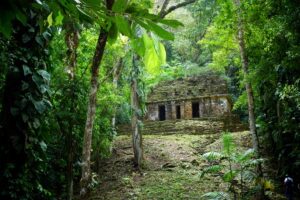
Structural remains in Yaxchilan, located on the bank of the Usumacinta River in the state of Chiapas, Mexico. Before the ‘collapse’, Yaxchilan was one of the most powerful Maya states in the Late Classic Period. RCK
____________________________
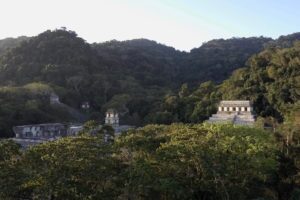
Above and below, structural remains at Palenque, one of the great Maya centers before the ‘collapse’. RCK
____________________________
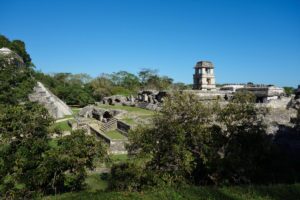
____________________________
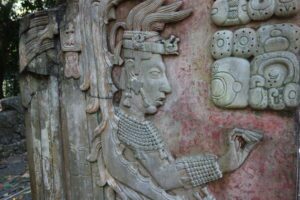
Palenque: Detail of stela with hieroglyphs. RCK
____________________________
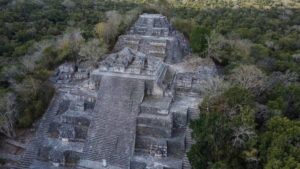
The massive pyramid at Calakmul, one of the great Maya centers before the ‘collapse’. RCK
____________________________
An Alternative Hypothesis
The facts gathered by Ford and Nigh as presented in The Maya Forest Garden argue strongly against the deforestation hypothesis commonly held today and paint a much more favorable picture of the Maya as examples of sustainability.
But as Ford has surmised, the knowledge of the Maya forest gardeners is a treasure that can easily be lost as older farmers pass away. It is happening now. The Maya know, as few people do, how to live sustainably with very few products from the outside world. Alfonso is saddened that he does not see an interest in his own children to pursue the life he is living. It is hard to disagree with Ford that the tremendous knowledge of the Maya master farmers, the results of thousands of years of trial and error, should not be treated lightly in a world searching for answers to environmental health and sustainability.
If, as Ford and Nigh claim, the ancient Maya used sustainable farming methods and did not suffer an environmental collapse, we must ask again: What did happen to impact a culture so grand that it could have left behind such an impressive archeological record?
We know that the Maya, sickened by European diseases, fought for their lands with the Spanish in the 1500s. The farmers still practiced the milpa cycle at that time, according to Ford and Nigh. Written works and ceremonial relics were destroyed. The Spaniards finally subdued the last Maya kingdom around Lake Peten Itza in 1697. Yet something did happen with the major centers of the Classic Period, well before the Spanish arrived. What Ford and others like her are suggesting is a political breakdown rather than an environmental one. The peasants, those doing the farming and the building, may have grown weary with the heavy conscription of their labor to build pyramids that simply paid homage to their kings. Hubris undoubtedly ran high as rulers, regaled in their jaguar skins and the colorful feathers of quetzals and parrots, sought to outdo one another. Routinely, they reconstructed the pyramids of former kings to make pyramids of their own. Costly wars, too, were matters of royal pride. The commoners may have ultimately rejected a regime of war and pomp.
Additionally, when periods of climate chaos came and the blood-letting rituals of kings and queens or the sacrificing of their wartime captives had no effect in reversing dire conditions brought on by deluge or drought, the people may have decided that they could do without their nobles, their wars and the pyramids that looked grand but could not fulfill their basic needs. During the eighth, ninth and tenth centuries, it seems that the pattern of powerful city states gradually reverted to small farms without ruling elites. The working classes shouldered on to live in a new way, only to be decimated by Spanish diseases five centuries later.
Anabel Ford and her forest gardeners would say that the great Maya civilization of the Classic Period never did collapse — it simply transformed.
____________________________
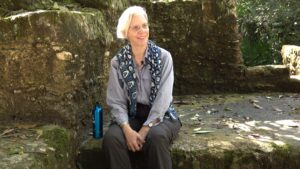
Dr. Anabel Ford has spent decades exploring and researching at El Pilar. RCK
____________________________


